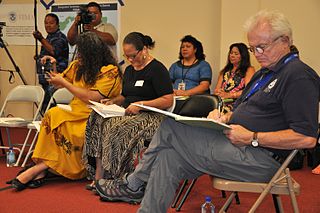Related Research Articles

Industrial and organizational psychology is the science of human behavior in the workplace and work-life interface. It is an applied discipline within psychology and is an international profession. Depending on the country or region of the world, I-O psychology is also known as occupational psychology in the United Kingdom, organisational psychology in Australia and New Zealand, and work and organizational (WO) psychology throughout Europe and Brazil. Industrial, work, and organizational (IWO) psychology is the broader, more global term for the science and profession.

Public relations (PR) is the practice of managing and disseminating information from an individual or an organization to the public in order to influence their perception. Public relations and publicity differ in that PR is controlled internally, whereas publicity is not controlled and contributed by external parties. Public relations may include an organization or individual gaining exposure to their audiences using topics of public interest and news items that do not require direct payment. The exposure is mostly media-based, and this differentiates it from advertising as a form of marketing communications. Public relations aims to create or obtain coverage for clients for free, also known as earned media, rather than paying for marketing or advertising also known as paid media. But in the early 21st century, advertising is also a part of broader PR activities.

An organization or organisation, is an entity—such as a company, an institution, or an association—comprising one or more people and having a particular purpose.

Leadership, both as a research area and as a practical skill, encompasses the ability of an individual, group, or organization to "lead", influence, or guide other individuals, teams, or entire organizations.

In social science and politics, power is the social production of an effect that determines the capacities, actions, beliefs, or conduct of actors. Power does not exclusively refer to the threat or use of force (coercion) by one actor against another, but may also be exerted through diffuse means. Power may also take structural forms, as it orders actors in relation to one another, and discursive forms, as categories and language may lend legitimacy to some behaviors and groups over others.
Historically there have been differences among investigators regarding the definition of organizational culture. Edgar Schein, a leading researcher in this field, defined "organizational culture" as comprising a number of features, including a shared "pattern of basic assumptions" which group members have acquired over time as they learn to successfully cope with internal and external organizationally relevant problems. Elliott Jaques first introduced the concept of culture in the organizational context in his 1951 book The Changing Culture of a Factory. The book was a published report of "a case study of developments in the social life of one industrial community between April, 1948 and November 1950". The "case" involved a publicly-held British company engaged principally in the manufacture, sale, and servicing of metal bearings. The study concerned itself with the description, analysis, and development of corporate group behaviours.
Servant leadership is a leadership philosophy in which the goal of the leader is to serve. This is different from traditional leadership where the leader's main focus is the thriving of their company or organization. A servant leader shares power, puts the needs of the employees first and helps people develop and perform as highly as possible. Instead of the people working to serve the leader, the leader exists to serve the people. As stated by its founder, Robert K. Greenleaf, a Servant Leader should be focused on, "Do those served grow as persons? Do they, while being served, become healthier, wiser, freer, more autonomous, more likely themselves to become servants?"
Opinion leadership is leadership by an active media user who interprets the meaning of media messages or content for lower-end media users. Typically opinion leaders are held in high esteem by those who accept their opinions. Opinion leadership comes from the theory of two-step flow of communication propounded by Paul Lazarsfeld and Elihu Katz. Significant developers of the opinion leader concept have been Robert K. Merton, C. Wright Mills and Bernard Berelson. This theory is one of several models that try to explain the diffusion of innovations, ideas, or commercial products.
Power distance refers to the unequal distribution of power between parties, and the level of acceptance of that inequality; whether it is in the family, workplace, or other organizations.
Authority in project management is the power that gives a project manager the ability to act in the name of the project sponsor executive or on behalf of the organization.
Transformational leadership is a theory of leadership where a leader works with teams or followers beyond their immediate self-interests to identify needed change, creating a vision to guide the change through influence, inspiration, and executing the change in tandem with committed members of a group; This change in self-interests elevates the follower's levels of maturity and ideals, as well as their concerns for the achievement. it is an integral part of the Full Range Leadership Model. Transformational leadership is when leader behaviors influence followers and inspire them to perform beyond their perceived capabilities. Transformational leadership inspires people to achieve unexpected or remarkable results. It gives workers autonomy over specific jobs, as well as the authority to make decisions once they have been trained. This induces a positive change in the followers attitudes and the organization as a whole. Transformational leaders typically perform four distinct behaviors, also known as the four I's. These behaviors are inspirational motivation, idealized influence, intellectual stimulation, individualized consideration.
A toxic leader is a person who has responsibility for a group of people or an organization, and who abuses the leader–follower relationship by leaving the group or organization in a worse condition than it was in. Good and bad leadership styles can propagate downwards in an organisation, and there may therefore be little support to be gained by reporting toxic leadership upwards in the hierarchy.
The following outline is provided as an overview of and topical guide to interpersonal relationships.
The leader–member exchange (LMX) theory is a relationship-based approach to leadership that focuses on the two-way (dyadic) relationship between leaders and followers.
Source credibility is "a term commonly used to imply a communicator's positive characteristics that affect the receiver's acceptance of a message." Academic studies of this topic began in the 20th century and were given a special emphasis during World War II, when the US government sought to use propaganda to influence public opinion in support of the war effort. Psychologist Carl Hovland and his colleagues worked at the War Department upon this during the 1940s and then continued experimental studies at Yale University. They built upon the work of researchers in the first half of the 20th century who had developed a Source-Message-Channel-Receiver model of communication and, with Muzafer Sherif, developed this as part of their theories of persuasion and social judgement.
In a notable study of power conducted by social psychologists John R. P. French and Bertram Raven in 1959, power is divided into five separate and distinct forms. They identified those five bases of power as coercive, reward, legitimate, referent, and expert. This was followed by Raven's subsequent addition in 1965 of a sixth separate and distinct base of power: informational power.

"Social identity approach" is an umbrella term designed to show that there are two methods used by academics to describe certain complex social phenomena- namely the dynamics between groups and individuals. Those two theoretical methods are called social identity theory and self-categorization theory. Experts describe them as two intertwined, but distinct, social psychological theories. The term "social identity approach" arose as an attempt to mitigate against the tendency to conflate the two theories, as well as the tendency to mistakenly believe one theory to be a component of the other. These theories should be thought of as overlapping. While there are similarities, self categorisation theory has greater explanatory scope and has been investigated in a broader range of empirical conditions. Self-categorization theory can also be thought of as developed to address limitations of social identity theory. Specifically the limited manner in which social identity theory deals with the cognitive processes that underpin the behaviour it describes. Although this term may be useful when contrasting broad social psychological movements, when applying either theory it is thought of as beneficial to distinguish carefully between the two theories in such a way that their specific characteristics can be retained.
In social psychology, collective narcissism is the tendency to exaggerate the positive image and importance of a group to which one belongs. The group may be defined by ideology, race, political beliefs/stance, religion, sexual orientation, social class, language, nationality, employment status, education level, cultural values, or any other ingroup. While the classic definition of narcissism focuses on the individual, collective narcissism extends this concept to similar excessively high opinions of a person's social group, and suggests that a group can function as a narcissistic entity.
The Three Levels of Leadership is a leadership model formulated in 2011 by James Scouller. Designed as a practical tool for developing a person's leadership presence, knowhow and skill, it aims to summarize what leaders have to do, not only to bring leadership to their group or organization, but also to develop themselves technically and psychologically as leaders. It has been classified as an "integrated psychological" theory of leadership. It is sometimes known as the 3P model of leadership.
A conflict is a struggle and a clash of interest, opinion, or even principles. Conflict will always be found in society; as the basis of conflict may vary to be personal, racial, class, caste, political and international. Conflict may also be emotional, intellectual, and theoretical, in which case academic recognition may, or may not be, a significant motive. Intellectual conflict is a subclass of cultural conflict, a conflict that tends to grow over time due to different cultural values and beliefs.
References
- ↑ "Referent Power in the Workplace". EPM. 20 June 2017. Retrieved 2020-11-08.
- ↑ "REVERENT | definition in the Cambridge English Dictionary". dictionary.cambridge.org. Retrieved 2020-11-08.
- ↑ "Definition of REFERENT". www.merriam-webster.com. Retrieved 2020-11-08.
- ↑ Raven, B. H. (2008), "The Bases of Power and the Power/Interaction Model of Interpersonal Influence", Analyses of Social Issues and Public Policy, Vol. 8, No. 1, p. 3